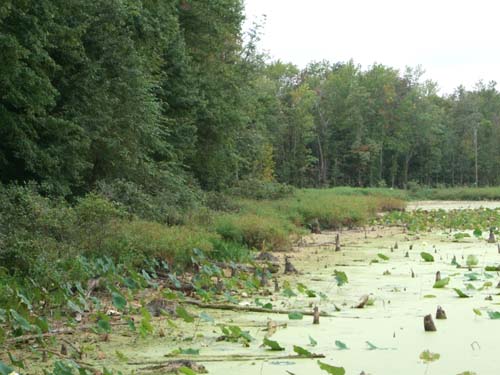
Of all the obstacles that ought to stop construction of Interstate 69 through southern Indiana, one of the most impressive is the Patoka River National Wildlife Refuge and Wildlife Management Area.
A sliver of nature on a north-south flyway for migrating birds, the 16-year-old refuge has become a stopover point for endangered whooping cranes and a breeding site for threatened bald eagles. Located in an area pockmarked by coalmines and drained for farming, it is one of the Midwest's few remaining stretches of bottomland hardwood forest. It provides homes to dozens of rare plant and animal species, including the endangered Indiana bat.
I would have thought the Patoka refuge would be protected by federal transportation law, which allows approval of such transportation projects on publicly owned land in a wildlife refuge only if there is "no prudent and feasible alternative" and only if the project minimizes harm.
There is, in fact, a "prudent and feasible alternative" to this route across the refuge. Opponents to I-69 have for years supported an alternate route that would upgrade existing roads between Indianapolis and Evansville. Using that alternate route, the state could avoid slicing across forests and family farms -- and through the Patoka River National Wildlife Refuge.
How, then, are Indiana's transportation officials getting away with running I-69 through the Patoka Refuge?
Here, in a nutshell, is the unhappy story, chronicled in one of the environmental impact statements for the project. When the refuge was being established back in the early 1990s, the state was already considering building a new highway that would speed up traffic between Evansville and Indianapolis. To get political support for establishing the refuge, the U.S. Fish and Wildlife Service agreed not to oppose the highway -- in fact, to be a "willing cooperator" with the Indiana Department of Transportation.
The FWS also agreed to "to attempt to avoid buying lands within the chosen alignment, thereby avoiding or minimizing the applicability of Section 4 (f)" -- the section of the 1966 Department of Transportation Act that prohibits projects like this on publicly owned land.
The state in turn promised to consult the FWS and minimize damage if and when the road was built.
As a result of that promise, the Indiana Department of Transportation now plans to run a nearly a mile-long bridge across the Patoka River and floodplain -- an expensive design move that will reduce some but not all of the highway's effects on the refuge. It will also cut down on road kill. "We don't want to interfere with the valley's movements of bats, birds, fish, mammals, box turtles, things like that," refuge director William McCoy told me in a long conversation in his Oakland City, Ind., office.
But the long bridge will do nothing to reduce the exhaust and noise from trucks hurtling through the refuge on their way to Mexico, Canada, and points in between.
McCoy's biggest worry is how the highway will affect the endangered Indiana bat. The federal Endangered Species Act forbids federal agencies from authorizing or funding any action that would jeopardize listed species or destroy critical habitat, and I-69 will run right through known Indiana bat territory. Research to assess the highway's threat to the bat population in the vicinity of the highway turned up a maternity roost tree a mile and a half from the center line of what will become the highway.
Imagining the refuge's future life with I-69, manager McCoy recalled the nights he'd spent at truck stops on interstates during his years with Fish and Wildlife. "You've got the brakes, people starting and stopping, all night long trucks sitting there idling, and the airbrakes going 'Whoosh.' I went to the planners, and I said, 'I don't want a pull-off, I don't want an exit, I want to get 'em through the valley as fast as they can go.'"
McCoy has lived with the prospect of I-69 since he arrived at the refuge in 1990 before it was even officially a refuge. He's seen the fortunes of the highway rise and fall. At one point, talk about the highway had died down so low that he made an offer to buy property for the refuge in what is now the I-69 corridor. No specific corridor had been designated at that point, and so -- he told me -- "I figured anything was fair game." He mailed the offer to the landowner, who got the appraisal on Friday and died on a Monday. The land went to his heirs, and now it will be part of a highway instead of the refuge.
Close call for I-69. Although the highway will run right through the 22,083-acre area authorized for acquisition by the Fish and Wildlife Service, none of the land it will take will be publicly owned. Thus, apparently, I-69 will be exempt from the Transportation Act's Section 4(f) prohibition against building a highway project on publicly owned land.
Except -- and this is a sizable "except" -- as Indiana University law professor Robert Fischman pointed out to me, the concept of "constructive use" could kick in here if the highway's impacts spill beyond its physical imprint onto publicly owned land. Under federal regulations, a transportation project cannot be built if its impacts "substantially impair" the features of a refuge. Such impacts are inevitable around this highway. A growing body of scientific research is showing the significant effects highways have on broad swaths of landscape and all that live within it.
As for the commitment the U.S. Fish and Wildlife Service made not to oppose a future highway when the refuge was being established, law professor Fischman gave me an opinion I take to be authoritative since he wrote the book in this area, The National Wildlife Refuges: Coordinating a Conservation System Through Law. "All the support in the world from FWS would not over-ride the statutory requirement in 4(f), which cannot be waived by a willing federal land manager," he said.
Like hundreds of other Hoosiers who have spoken out against the new-terrain I-69, I can't help but think that more than soil is being eroded as the bulldozers move in to start building this highway: our faith in democracy and the rule of law is fading fast.

